Project Year
2009
Region(s)
South Asia
Country(ies)
India
Project Description
This proposal is a continuation of a PhD study on the Konda Reddis, who are classified as a ‘Particularly Vulnerable Tribal Group’ by the Government of India. It will examine the process of use of different forms of money that operate with the Konda Reddis and examine the social fabric of money and financial services they use. By utilizing established relationships and previously collected ethnographic data, this study will further research using the extended case method and situational analysis as it performs an inquiry into the process of use of different forms of money that operate with the Konda Reddis.
Researcher(s)
Thanuja Mummidi
About the Researcher(s)

Synopsis of Research Results
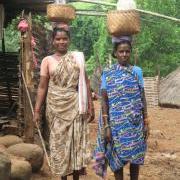 The poor are largely defined on the basis of financial status and behaviour, which
is narrowly equated with their access to and use of state currencies. In contrast,
this study finds that among the Konda Reddis of south India different stores of value
co-exist with state currencies. These stores of value can be seen as different forms
of money with varying levels of transferability, with value and transferability locally
constituted. At the same time, neither the form nor the value and transferability
of local forms of money are static but rather transform in accordance to changes outside
the local sphere. The paper argues, using the case of the Konda Reddis, that there
are different forms of money which do not get replaced or substituted but co-exist
with new entrants in turn having different standards or value which contribute to
the complexity of financial behaviour.
The poor are largely defined on the basis of financial status and behaviour, which
is narrowly equated with their access to and use of state currencies. In contrast,
this study finds that among the Konda Reddis of south India different stores of value
co-exist with state currencies. These stores of value can be seen as different forms
of money with varying levels of transferability, with value and transferability locally
constituted. At the same time, neither the form nor the value and transferability
of local forms of money are static but rather transform in accordance to changes outside
the local sphere. The paper argues, using the case of the Konda Reddis, that there
are different forms of money which do not get replaced or substituted but co-exist
with new entrants in turn having different standards or value which contribute to
the complexity of financial behaviour.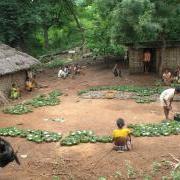 The Konda Reddis are classified by the government of India as a ‘Particularly Vulnerable
Tribal Group’ (PTG). The PTG category was created in 1969 to include those groups
who lived in relatively isolated geographical regions, engaged in subsistence labor
that relied primarily on pre-agricultural technology, with stagnant or diminishing
population rates and low levels of literacy in comparison to the national average.
The Konda Reddis are one among the seventy-five communities belonging to this category
and live mainly in the forested tribal concentration region of north-central and eastern
parts of Andhra Pradesh state in south India. Konda Reddis participate in diversified
livelihood strategies centered around shifting cultivation. As argued elsewhere (Thanuja,
2005), shifting cultivation is a diversified strategy because it allows management
of time, space and labour in practicing hunting, gathering, rearing livestock, maintaining
kitchen gardens and making of bamboo ware. Land is communal property owned or claimed
by different lineages but with residence and marriage choices being quite inclusive
allows mobility and access to cultivation land across the whole territory to members
of different lineages.
The Konda Reddis are classified by the government of India as a ‘Particularly Vulnerable
Tribal Group’ (PTG). The PTG category was created in 1969 to include those groups
who lived in relatively isolated geographical regions, engaged in subsistence labor
that relied primarily on pre-agricultural technology, with stagnant or diminishing
population rates and low levels of literacy in comparison to the national average.
The Konda Reddis are one among the seventy-five communities belonging to this category
and live mainly in the forested tribal concentration region of north-central and eastern
parts of Andhra Pradesh state in south India. Konda Reddis participate in diversified
livelihood strategies centered around shifting cultivation. As argued elsewhere (Thanuja,
2005), shifting cultivation is a diversified strategy because it allows management
of time, space and labour in practicing hunting, gathering, rearing livestock, maintaining
kitchen gardens and making of bamboo ware. Land is communal property owned or claimed
by different lineages but with residence and marriage choices being quite inclusive
allows mobility and access to cultivation land across the whole territory to members
of different lineages. 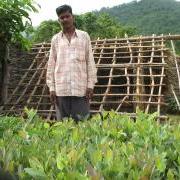 The main ‘goods’ exchanged are products of cultivation, hunting, collection, livestock
and bamboo ware and human labour. These goods must be understood as different forms
of money among the Konda Reddis, exchanged alongside and in conjunction with state
currency.
The main ‘goods’ exchanged are products of cultivation, hunting, collection, livestock
and bamboo ware and human labour. These goods must be understood as different forms
of money among the Konda Reddis, exchanged alongside and in conjunction with state
currency.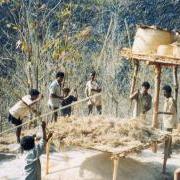 The kallu belonged exclusively to Gangi Reddi and he was free to barter the kallu. In fact for every collection men and women from neighbouring settlements either
gathered by the tree or at Gangi Reddi’s house for a drink. Sometimes a member of
a neighbouring settlement carried the collected kallu in gourd bottles back to his/her settlement. For two gourd bottles of kallu which can hold approximately three litres each either three kg of pearl millet or
two kg of rice or a kilogram of pulse was exchanged. The kallu also attracted Koya’s from the plains. The jirugu kallu was considered superior in taste to thati kallu (toddy) available in the plains from January to May. The article for barter with kallu, its quantity and time of exchange were not rigid and often individuals had a glass
or two of kallu for no payment. Because Kadambal Bul Reddi was recognized as the original owner of
the tree he was always given kallu whenever he came to the tree for no article in exchange. Nevertheless, in the seven
months of tapping kallu Gangi Reddi had earned sufficient food stores for the year and exchange partners
for the future.
The kallu belonged exclusively to Gangi Reddi and he was free to barter the kallu. In fact for every collection men and women from neighbouring settlements either
gathered by the tree or at Gangi Reddi’s house for a drink. Sometimes a member of
a neighbouring settlement carried the collected kallu in gourd bottles back to his/her settlement. For two gourd bottles of kallu which can hold approximately three litres each either three kg of pearl millet or
two kg of rice or a kilogram of pulse was exchanged. The kallu also attracted Koya’s from the plains. The jirugu kallu was considered superior in taste to thati kallu (toddy) available in the plains from January to May. The article for barter with kallu, its quantity and time of exchange were not rigid and often individuals had a glass
or two of kallu for no payment. Because Kadambal Bul Reddi was recognized as the original owner of
the tree he was always given kallu whenever he came to the tree for no article in exchange. Nevertheless, in the seven
months of tapping kallu Gangi Reddi had earned sufficient food stores for the year and exchange partners
for the future.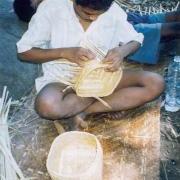 Other forms of additional labor that the Konda engaged in during non-cultivation periods
that allowed them to participate in the local economy include bamboo basket weaving. Konda
Reddi women typically make baskets and sell them at the weekly village market through
trade intermediaries from another tribal group, the Koya; Konda Reddi men raise cash
through the collection and sale of honey and resin. The cash earned from these sales
is compounded by the value of the long-term partnership, loans, and the availability
of goods made possible by these exchange networks. As such, the cash value of bamboo
baskets, honey, resin and other produced goods is only part of its value. On the other
hand, pearl millet, produced through shifting cultivation is not sold for cash but
is primarily used for household consumption and as a medium of trade between households
in exchange for labor and ritual contributions. These exchanges qualify as gifts yet
are part of repciprocal networks within the community through which collective harvesting
labor is exchanged for cooked food or harvested grain and accrues respect and recognition
within the community.
Other forms of additional labor that the Konda engaged in during non-cultivation periods
that allowed them to participate in the local economy include bamboo basket weaving. Konda
Reddi women typically make baskets and sell them at the weekly village market through
trade intermediaries from another tribal group, the Koya; Konda Reddi men raise cash
through the collection and sale of honey and resin. The cash earned from these sales
is compounded by the value of the long-term partnership, loans, and the availability
of goods made possible by these exchange networks. As such, the cash value of bamboo
baskets, honey, resin and other produced goods is only part of its value. On the other
hand, pearl millet, produced through shifting cultivation is not sold for cash but
is primarily used for household consumption and as a medium of trade between households
in exchange for labor and ritual contributions. These exchanges qualify as gifts yet
are part of repciprocal networks within the community through which collective harvesting
labor is exchanged for cooked food or harvested grain and accrues respect and recognition
within the community.


